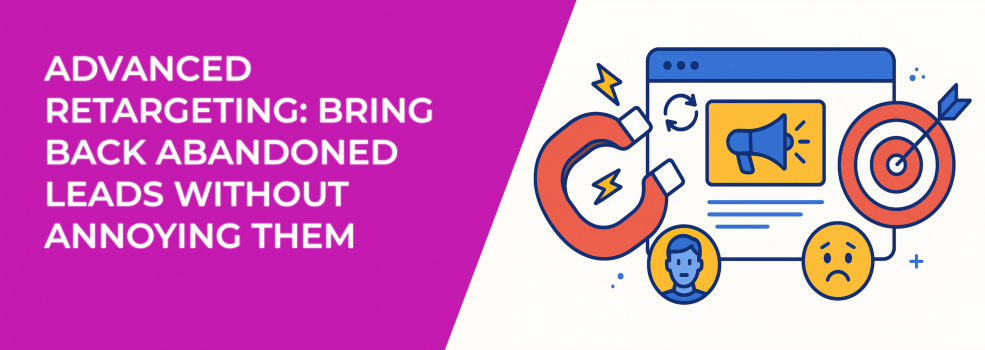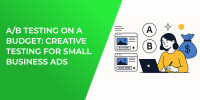Every advertiser has felt this pain: a promising visitor clicks through your ad, browses a product or two, maybe even adds to cart — then disappears.
So, what now?
Many marketers respond by hammering users with retargeting ads until the person either converts or blocks them. But that approach does more harm than good. Today’s users expect personalization, not persistence.
Retargeting still works. But only if you do it right. That means thoughtful segmentation, creative that feels relevant, and a careful approach to frequency and timing.
Let’s explore how to bring abandoned leads back into your funnel — without driving them away in the process.
1. Identify the Type of Lead You’re Retargeting
Not all website visitors leave for the same reason. Understanding why someone abandoned your site is the first step toward creating a message that resonates.
Segment your retargeting audiences by behavior:
-
Bounce visitors: Users who left quickly. These visitors need to be reassured — show them credibility signals, customer reviews, or a simple explainer.
-
Page browsers: People who explored multiple products or spent time reading content. Try retargeting them with educational ads or content that highlights benefits.
-
Cart abandoners: High-intent users who almost bought. Focus on reminders, urgency, and finishing the purchase process.
Once you understand where someone dropped off, you can tailor your messaging and offers accordingly. Facebook Custom Audiences makes this level of segmentation relatively easy, especially if you’ve set up your pixel events properly.
For a deeper dive into defining audience segments from scratch, check out our guide on how to define a target audience for marketing.
2. Create Ads That Continue the Conversation
Retargeting ads should feel like a follow-up, not a reset. If someone already interacted with your brand, treat the ad as a continuation of that experience.
Mix and match formats and approaches:
-
Testimonials or reviews: Use social proof to strengthen trust.
-
Short video demos: Reinforce product benefits visually and quickly.
-
Product highlights: Remind users of items they viewed, or show alternatives.
-
Conversational copy: Address hesitations directly, using soft language and helpful cues.
This kind of content builds on what the lead already knows and helps move them closer to a decision. Use your analytics to find which formats your audience responds to best — and rotate your creatives frequently to avoid ad fatigue.
Creative performance often depends on the format and placement. Learn how to pick the right format in The Ultimate Guide to Facebook Ad Formats.
3. Avoid Overexposure With Smart Frequency and Timing
Showing your ad too often — or too soon — can quickly become annoying. And once users associate your brand with irritation, it’s tough to undo.
CTR drops as ad frequency increases — find your optimal exposure window to avoid ad fatigue.
Control your campaign dynamics:
-
Limit daily frequency: One or two impressions per day is often enough.
-
Use time windows: Retarget recent visitors with different urgency levels (e.g., 1–3 days vs. 14–30 days).
-
Sequence your messaging: Start with product-focused ads, then move to offers or urgency later.
By pacing your ads appropriately, you give users time to consider without feeling pressured. This makes your brand feel more thoughtful and more trustworthy.
If your ads are still underperforming despite good timing, review this guide on how frequency capping helps beat Facebook ad fatigue.
4. A/B Test Your Retargeting Ads — Just Like You Do at the Top of Funnel
Advertisers often forget that retargeting audiences can (and should) be tested like cold traffic. These leads are valuable, and even small performance improvements can drive real revenue.
Experiment with variables such as:
-
Messaging tone: Direct vs. soft, value-first vs. benefit-focused.
-
Incentives: Discount vs. bonus item vs. limited-time offer.
-
Creative format: Static vs. carousel vs. video.
Be sure to measure meaningful metrics like ROAS and cost-per-conversion, not just click-through rate. Over time, your best-performing combinations will emerge — and you can double down on what works.
5. Scale Lookalike Audiences With High-Intent Data
Once your retargeting sequences are converting well, you can use them to build broader audiences. But you’ll need the right data to do it.
Start with:
-
Purchase events: The strongest signal for lookalike audiences.
-
Cart abandoners who returned: These users demonstrate recovery potential.
-
High-value customers: Define by frequency, LTV, or average order value.
Avoid using general page traffic or all ad clickers as seed audiences. They’re too broad and dilute the quality of your lookalikes. The more precise your source, the more relevant your lookalike will be.
Once built, layer your lookalikes with interest targeting or behaviors to keep performance sharp. You’ll increase your reach but without losing efficiency.
6. Avoid Retargeting Pitfalls That Hurt Performance
Even with a smart strategy, a few common missteps can damage results. Be proactive in avoiding them.
Keep an eye out for:
-
Retargeting too soon: Give users a short delay before serving ads.
-
Reusing the same creative: Rotate copy and images every 10–14 days.
-
Showing irrelevant products: Make sure you’re retargeting based on actual behavior.
-
Ignoring device behavior: Test mobile-specific creatives, especially for Instagram.
Consistency matters, but repetition kills interest. Instead of doubling down on frequency, double down on relevance.
Still not seeing conversions? Troubleshoot with our checklist on Facebook Ads Not Converting: How To Fix It.
Final Thought: Retarget Like a Brand People Trust
Retargeting isn’t just about reminding people that you exist. It’s about helping them return with more confidence and less friction. When done well, it enhances user experience and builds credibility.
Ask yourself:
-
Did the visitor need more information?
-
Were they hesitating because of price, trust, or timing?
-
What kind of message would be most helpful right now?
Answering those questions allows you to design campaigns that feel aligned with your audience — not forced.

